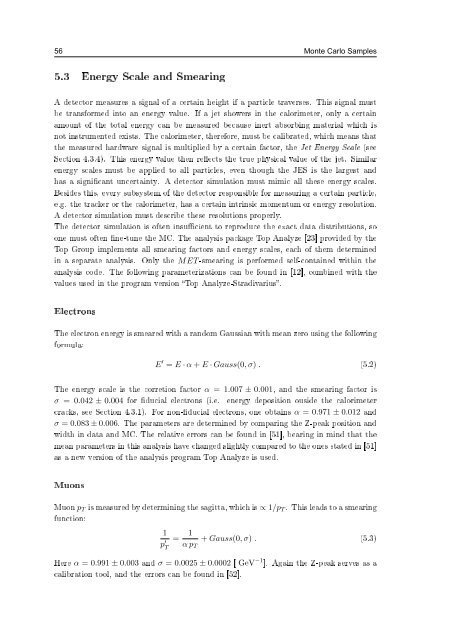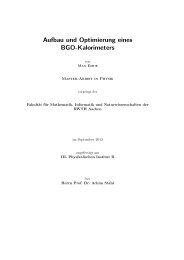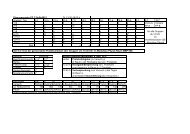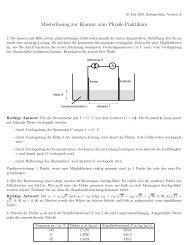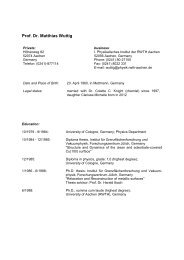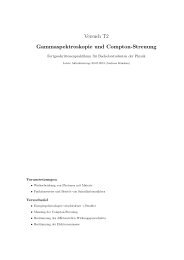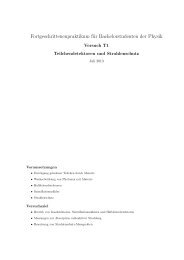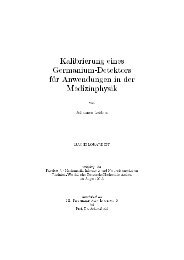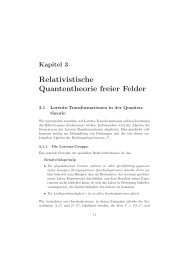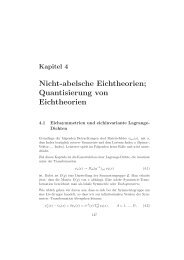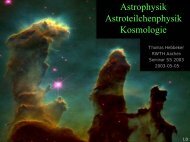Model Independent Search for Deviations from the Standard Model ...
Model Independent Search for Deviations from the Standard Model ...
Model Independent Search for Deviations from the Standard Model ...
You also want an ePaper? Increase the reach of your titles
YUMPU automatically turns print PDFs into web optimized ePapers that Google loves.
56 Monte Carlo Samples<br />
5.3 Energy Scale and Smearing<br />
A detector measures a signal of a certain height if a particle traverses. This signal must<br />
be trans<strong>for</strong>med into an energy value. If a jet showers in <strong>the</strong> calorimeter, only a certain<br />
amount of <strong>the</strong> total energy can be measured because inert absorbing material which is<br />
not instrumented exists. The calorimeter, <strong>the</strong>re<strong>for</strong>e, must be calibrated, which means that<br />
<strong>the</strong> measured hardware signal is multiplied by a certain factor, <strong>the</strong> Jet Energy Scale (see<br />
Section 4.3.4). This energy value <strong>the</strong>n reects <strong>the</strong> true physical value of <strong>the</strong> jet. Similar<br />
energy scales must be applied to all particles, even though <strong>the</strong> JES is <strong>the</strong> largest and<br />
has a signicant uncertainty. A detector simulation must mimic all <strong>the</strong>se energy scales.<br />
Besides this, every subsystem of <strong>the</strong> detector responsible <strong>for</strong> measuring a certain particle,<br />
e.g. <strong>the</strong> tracker or <strong>the</strong> calorimeter, has a certain intrinsic momentum or energy resolution.<br />
A detector simulation must describe <strong>the</strong>se resolutions properly.<br />
The detector simulation is often insucient to reproduce <strong>the</strong> exact data distributions, so<br />
one must often ne-tune <strong>the</strong> MC. The analysis package Top Analyze [23] provided by <strong>the</strong><br />
Top Group implements all smearing factors and energy scales, each of <strong>the</strong>m determined<br />
in a separate analysis. Only <strong>the</strong> MET-smearing is per<strong>for</strong>med self-contained within <strong>the</strong><br />
analysis code. The following parameterizations can be found in [12], combined with <strong>the</strong><br />
values used in <strong>the</strong> program version Top Analyze-Stradivarius.<br />
Electrons<br />
TheelectronenergyissmearedwitharandomGaussianwithmeanzerousing<strong>the</strong>following<br />
<strong>for</strong>mula:<br />
E ′ = E · α + E · Gauss(0, σ) . (5.2)<br />
The energy scale is <strong>the</strong> corretion factor α = 1.007 ± 0.001, and <strong>the</strong> smearing factor is<br />
σ = 0.042 ± 0.004 <strong>for</strong> ducial electrons (i.e. energy deposition ouside <strong>the</strong> calorimeter<br />
cracks, see Section 4.3.1). For non-ducial electrons, one obtains α = 0.971 ± 0.012 and<br />
σ = 0.083 ± 0.006. The parameters are determined by comparing <strong>the</strong> Z-peak position and<br />
width in data and MC. The relative errors can be found in [51], bearing in mind that <strong>the</strong><br />
mean parameters in this analysis have changed slightly compared to <strong>the</strong> ones stated in [51]<br />
as a new version of <strong>the</strong> analysis program Top Analyze is used.<br />
Muons<br />
Muon p T ismeasuredbydetermining<strong>the</strong>sagitta,whichis ∝ 1/p T . Thisleadstoasmearing<br />
function:<br />
1<br />
p ′ T<br />
= 1<br />
α p T<br />
+ Gauss(0, σ) . (5.3)<br />
Here α = 0.991 ± 0.003 and σ = 0.0025 ± 0.0002 [ GeV −1 ]. Again <strong>the</strong> Z-peak serves as a<br />
calibration tool, and <strong>the</strong> errors can be found in [52].


